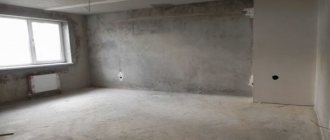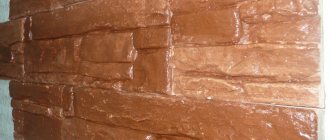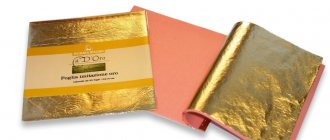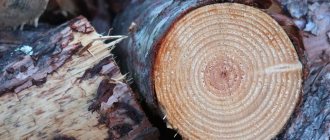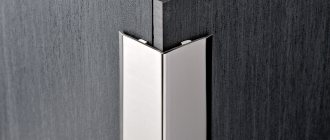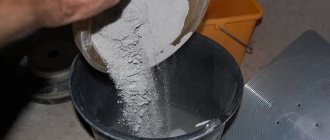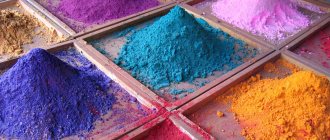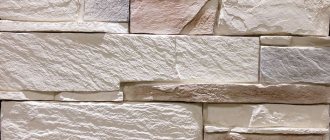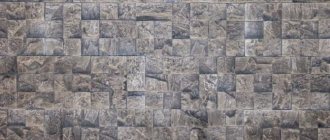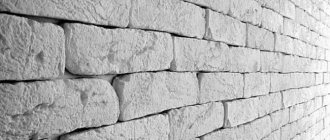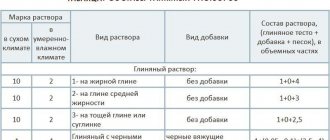Cement provides high strength and frost resistance, gypsum provides rapid strength gain. The option arises of mixing gypsum and cement and obtaining a high-strength binder with a rapid increase in strength. But it’s absolutely impossible to do this, and here’s why.
When mixing such a mixture with water (hydration), a reaction occurs between the aluminate components of clinker and semi-aqueous gypsum, which results in the formation of a high-sulfate form of calcium hydrosulfoaluminate - ettringite (another name for “cement bacillus”) . Ettringite (calcium hydrosulfoaluminate) greatly increases in volume during the process of gaining strength (hydration) and literally “tears” the cement stone.
That is why if you simply mix semi-aqueous gypsum with cement, after a short period of time the concrete based on such a complex binder (cement-gypsum) will simply collapse due to the development of the “cement bacillus” (formation and hydration of ettringite).
To prevent the formation of ettringite, it is necessary to add pozzolanic additives of natural (tripoli, opoka, diatomite) or artificial origin (acid blast furnace slag) to the gypsum + cement composition. The mechanism of action of pozzolanic (hydraulic) additives containing silica in active form is to reduce the concentration of calcium hydroxide in the gypsum-cement system, which allows almost completely avoiding the formation of ettringite (“cement bacillus”).
As a result, we get gypsum-cement-pozzolanic binder GCPV . Based on HCPV, it is possible to produce concrete with a strength of 15-40 MPa with frost resistance of 25-300 cycles and above. Modern GCPVs contain a set of binders, pozzolanic, plasticizing, thresholding and other additives and fillers carefully selected in terms of their quantitative composition. Such mixtures (for example, Stonemaker) make it possible to produce stone that hardens in less than 60 minutes and has a final strength of up to 40 MPa and frost resistance of up to 300 cycles, which allows it to be successfully used for the production of artificial stone for facade finishing.
If you do not want to deal with the preparation of GCPV yourself, with the risk of the formation of a “cement bacillus” and possible destruction of the stone, you can increase the strength of ordinary gypsum almost 10 times by using a special additive - gypsum strength activator SVV-500. This gypsum additive at a low consumption (up to 5% of the gypsum weight) allows you to increase the strength of the finished gypsum stone by an order of magnitude. You can also use the polycarboxylate hyperplasticizer MasterGlenium-115, which reduces the amount of mixing water by 35-40% (with the same fluidity of the mixture), which increases the strength of products made from such gypsum several times.
Use of gypsum for cement production
Cement is a multicomponent material, which includes:
- clayey rocks (loam, clay, shale, loess or loess-like loams);
- mineral rocks of the carbonate group (calcite, dolomite, limestone, chalk, marl).
If we consider the chemical composition of cement, it contains oxides of aluminum, silicon, magnesium, iron, and calcium.
During the production of cement, natural materials are dried, ground and mixed, after which the mixture is heated to high temperatures. The resulting clinker is ground again - the powder should be fine. Then various modifier additives are introduced to give the material certain properties.
Gypsum is added to all types of cement mixture to prevent rapid setting of the solution - this allows the material, ready for use, to be transported over the required distances. In addition, gypsum adds strength to the solution. The percentage of gypsum in cement is strictly defined - the volume of the additive is 3-6%, no more.
Is it possible to add cement to gypsum plaster?
When mixing such a mixture with water (hydration), a reaction occurs between the aluminate components of clinker and semi-aqueous gypsum, which results in the formation of a high-sulfate form of calcium hydrosulfoaluminate - ettringite (another name for “cement bacillus”) . Ettringite (calcium hydrosulfoaluminate) greatly increases in volume during the process of gaining strength (hydration) and literally “tears” the cement stone.
That is why if you simply mix semi-aqueous gypsum with cement, after a short period of time the concrete based on such a complex binder (cement-gypsum) will simply collapse due to the development of the “cement bacillus” (formation and hydration of ettringite).
To prevent the formation of ettringite, pozzolanic additives of natural (tripoli, opoka, diatomite) or artificial origin (metakaolin, microsilica, white soot) must be added to the gypsum + cement composition. The mechanism of action of pozzolanic (hydraulic) additives containing silica in active form is to reduce the concentration of calcium hydroxide in the gypsum-cement system, which allows almost completely avoiding the formation of ettringite (“cement bacillus”).
As a result, we get gypsum-cement-pozzolanic binder GCPV . Based on HCPV, it is possible to produce concrete with a strength of 15-80 MPa with frost resistance of 25-300 cycles and above. Modern GCPVs contain a set of binders, pozzolanic, plasticizing, thresholding and other additives and fillers carefully selected in terms of their quantitative composition. Such mixtures (for example, Kamnedel, BystroBeton) make it possible to produce stone that hardens in less than 60 minutes and has a final strength of up to 80 MPa and frost resistance of up to 300 cycles, which allows it to be successfully used for the production of artificial stone for facade finishing.
If you do not want to deal with the preparation of GCPV yourself, with the risk of the formation of a “cement bacillus” and possible destruction of the stone, you can increase the strength of ordinary gypsum almost 10 times by using a special additive - gypsum strength activator SVV-500. This gypsum additive, at low consumption (up to 5% of the gypsum weight), allows you to increase the strength of the finished gypsum stone by an order of magnitude. You can also use the polycarboxylate hyperplasticizer MasterGlenium-115, or a new generation plasticizer based on polyarylates MasterPolyHeed 3043, which reduces the amount of mixing water by 35-40% (with the same fluidity of the mixture), which increases the strength of products made from such gypsum several times.
Ettringite or "cement bacillus"
Is it possible to mix gypsum with cement to obtain a universal solution that can be applied in a thick layer and allows you to level a surface with noticeable defects in one go? Despite the fact that this approach is practiced by unscrupulous private craftsmen, adding gypsum or alabaster to the cement-sand mixture is strictly not recommended.
The aluminate components of cement react with gypsum when mixed with water, resulting in the formation of calcium hydrosulfoaluminate - ettringite. In ancient times, the appearance of ettringite was called “cement bacillus” - as the crystals gain strength, they greatly increase in volume and destroy the cement stone; it is impossible to resist this process.
Hydration (addition of water molecules) occurs not only during the preparation of the solution, but also under the influence of moisture on the material - for example, if the walls are plastered with a cement-gypsum mixture in a room with a high level of humidity or in the open air.
Possible problems when using metakaolin
Previously, it was pointed out that an overdose of microsilica is inadmissible. The same applies to metakaolin.
Here are some recommendations from the developer of the VMC when using it as part of the GCPV.
To reliably prevent the uncontrolled formation of ettringite in HCPV compositions, it is sufficient to add 10% metakaolin to Portland cement.
This leads to a dosage of IUDs of only 1-2% of the composition.
Just like microsilica, VMK is a finely dispersed powder. It is prone to flocculation and requires the mandatory introduction of an effective dispersant (plasticizer).
Thorough mixing of the solution is also necessary.
Despite many recommendations to administer IUD in amounts up to 20%, experience has shown that an overdose can adversely affect the strength of the stone.
This is due to two reasons:
- If there is a lack of lime and other materials with which the VMC could react, it becomes an inert filler.
- High dosages of VMC significantly change the granulometry of the entire composition.
Source
Sad consequences
Unscrupulous performers use a solution of cement and gypsum for rough plastering of surfaces - the mixture is well laid in a thick layer and hardens quickly. This allows you to increase the speed of finishing work many times over, since without gypsum the cement-sand mixture has to be applied to concrete walls in layers with intermediate drying for several hours.
However, such plaster very quickly, within one to five days, becomes covered with a dense network of microcracks. If the material is applied to a red brick wall indoors, then the situation can be saved by a finishing layer of cement mortar without plaster or façade putty. In the case of concrete walls, this technology will not bring results.
Gypsum added to a cement-sand mortar sets quickly - the plaster becomes hard a few minutes after application, but it takes much longer to dry and is at the same time exposed to the “cement bacillus” due to the chemical reaction that occurs.
As a result, a plaster layer made from a mixture of gypsum and cement inside a dry room can last up to 5 years without collapsing, but on the façade of a building it will become unusable after the first winter. If a metal mesh is used for reinforcement, it will quickly begin to rust, since the plaster absorbs moisture due to the introduction of gypsum. Traces of rust will appear on the surface of the plastered wall.
Preparation of different types of solutions
Finishing mixtures differ in composition and proportions of consumable materials. The choice of a specific recipe for preparing the solution and the rate of its consumption depends on the desired result.
Lime based plasters
Lime solutions are inexpensive. They are used for interior work in an apartment with normal humidity levels. The material is safe, has good thermal insulation, is easy to prepare, is characterized by low consumption, but is short-lived.
How to prepare lime mortar for plaster? You need to take 1 volume part of lime paste and 1-5 parts of sand (depending on the type of lime). Sand should be added to the lime mixture in portions, mixing thoroughly until smooth.
Note: the lime mortar is prepared immediately before use, since it sets in 10 minutes and dries quickly. Lime mortar for plaster, proportions - table
Gypsum will speed up the setting of lime and reduce its consumption. First, gypsum and water are mixed in a ratio of 1:1.5, and then 3-4 parts of lime are added.
Please note: the process of preparing a lime-gypsum mortar should last no more than 2 minutes, since the mixture sets in 5 minutes and completely hardens in 30.
Table of the ratio of parts of lime-gypsum mortar
Cement coatings
These mixtures are used for external/internal work, since they are resistant to moisture and have good vapor permeability. The coating dries in 4 weeks and can be treated no later than an hour after application.
These solutions are:
- cement-sand - used for leveling and finishing walls made of different materials (except concrete);
- cement-lime - used for finishing surfaces made of ceramics, brick, concrete. They are inexpensive, durable, flexible, and have excellent adhesion to other materials;
- cement-lime-sand - used in construction, finishing of concrete, brick, wooden walls.
Recommendation: it is preferable to use cement-lime mixture for finishing walls inside buildings with high humidity.
The lime-cement mixture allows you to create coatings of varying degrees of granularity.
How to make a mortar for plaster from cement? The composition of the cement-lime mortar includes:
- binders (fresh cement grade 400, 500, slaked lime);
- filler (river/quarry sand, sifted on a mesh with 3-5 mm cells)
- water.
Advice: to increase plasticity and reduce the consumption of the mixture, plasticizers, PVA glue (0.5 l/20 l of solution), liquid soap (0.2 l/20 l of solution), as well as substances that enhance its heat-, frost resistance.
What is the optimal ratio of sand and cement for plaster? Lime-cement mortar for plastering walls can have different proportions. Most often it is: cement, liquid lime, sand in a ratio of 1:1:6, or 1:2:9. Cement-based mortar should be prepared in small quantities in order to be used quickly - it sets in 40-50 minutes, losing its properties.
Table - proportions of cement and sand for plastering walls
Clay based solution
The main components of plaster are clay and sand. These ingredients are pre-soaked in water and then diluted to the consistency of sour cream.
Note: due to its excellent astringent properties, plasticity, naturalness, and water resistance, clay is used for finishing the oven.
The composition of the clay solution depends on the purpose of its consumption
Decorative mixtures for interior and facade work are mainly sold in the form of a ready-made mass and applied to the surface using a certain technology. So “Venetian” is a solution on a lime or acrylic base with the addition of fine marble chips.
Thanks to the application of the mixture in thin layers, the “Venetian” has a low consumption and completely imitates the pattern of marble
The façade covering “bark beetle” can be acrylic or gypsum. It is sold in the form of a paste or dry ingredients.
The mixture contains small granular pebbles, which, thanks to a special application technology, imitate the movements of the bark beetle
Often, when finishing facades, structural terrazite plaster is used, creating the effect of a rock coating. You can prepare this mixture with your own hands using mica, cement, slaked lime, fillers (stone chips, quartz sand).
An example of how to make decorative plaster with your own hands
When preparing a solution for plaster, the proportions of the ingredients depend on the application layer. When spraying and priming, a small amount of binder is consumed (weak solution), while the final coating uses a maximum of binder components to ensure its strength.
Remember: the mixture must dry at a temperature of - +5-+25˚С in dry weather.
Application of gypsum-cement mixture
Before modifiers that could increase the adhesion of the solution began to be widely used, gypsum was added to the cement-sand mixture for plastering ceilings and upper slopes to simplify the work. As a result, it was necessary to regularly repair the ceilings, since after a few years the plaster could begin to fall off in pieces.
Cement and gypsum can be mixed to obtain an effective binder under one condition - pozzolanic additives, which contain silica in active form, are introduced into the mixture. These can be materials of natural origin (opka, diatomite, tripoli) or artificial (acid blast furnace slag). Silica reduces the concentration of calcium hydroxide in the mixture, thereby preventing the formation of ettringite.
Gypsum with cement for the production of artificial stone and decor based on HCPV
Let us immediately note that the material is given on the basis of the practical experience of many craftsmen in the manufacture of gypsum products.
To strengthen the latter, cement is added to the mixture. But what do experts do to avoid the previously described problems?
To do this, pozzolans are included in the mixture.
Previously, the following active mineral additives were used: tripoli, opoka, diatomite, acidic slag and ash, volcanic ash, traces and others.
But their times have already passed and now the most modern pozzolan is used - highly active metakaolin (HMC).
Also today, many people use less active, but cheaper silica fume.
Their comparative characteristics were described in sufficient detail in the corresponding article on kamsaddeco.com.
The mixture, which includes gypsum, cement and pozzolans, is called gypsum cement pozzolanic binder.
The inclusion of cement in the gypsum base is associated not only with strengthening the product. Often pure gypsum castings warp when drying. They change their geometry.
The addition of cement compensates for the deformation. Expansion and contraction balance the material.
In addition, the surface of such a product the next day is much stronger than that made from pure plaster. It is drier and can be painted. This also speeds up the process.
Now in more detail about the composition of the GCPV
In addition to gypsum, cement and pozzolana, various plasticizers are added to the mixture.
Which plasticizer to use depends on the type of pozzolanic additive used.
Thus, the developers of the VMK, when using it, recommend including a plasticizer based on polycarboxylates in the HCPV composition.
The amount of pozzolana used in a mixture depends on its activity.
If we take ordinary natural pozzolans (for example, diatomite), then the amount of additive will be significantly greater than when using microsilica.
But even this cannot be increased beyond a certain value (20%). Large volumes begin to work not as active additives, but as a regular filler.
This may reduce the strength of the stone. This is due to the deterioration of the hydration process due to excess filler. Just like with too much dye.
Reviews about the features of the application. Applying cement to plaster
Many consumers are wondering whether it is possible to apply cement putty to gypsum plaster. From experience, this idea is not the best solution. Cement mixtures mainly act as base surfaces, as they are quite rough to use, so obtaining an even base under such conditions will be almost impossible, according to home craftsmen.
It is also not recommended to place cement plaster on a gypsum wall, since an alkaline reaction will occur upon contact with water. Cement is a strong base, and gypsum does not like alkalis. Theoretically, this option for carrying out the work is possible; the cement composition can be laid on a gypsum wall, but when wet, the bottom layer will lose strength, and the material on top will have low laminar strength. Therefore, consumers emphasize that anhydrite and gypsum bases should be classified as complex.
